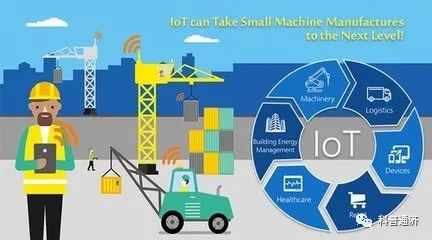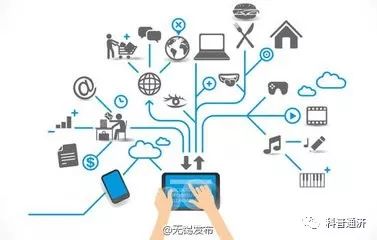The Internet of Things (IoT) is an important component of the new generation of information technology and a significant development phase in the “information age.” As the name suggests, the IoT is an internet that connects everything. This has two implications: first, the core and foundation of the IoT remains the internet, which is an extension and expansion of the network based on the internet; second, its user-side extends and expands to any items, enabling information exchange and communication between items, which is the essence of interconnectivity.
The IoT utilizes communication technologies such as local networks or the internet to connect sensors, controllers, machines, personnel, and objects in new ways, forming a network that connects people to objects and objects to objects, achieving informatization, remote management control, and intelligent networking. The IoT is an extension of the internet, encompassing all resources on the internet, compatible with all applications of the internet, but all elements in the IoT (all devices, resources, and communications) are personalized and private.
Basic Connotation The concept of the IoT was proposed in 1999, with its English name: Internet of Things (IoT), also referred to as the Web of Things. It is seen as an application extension of the internet, with application innovation being the core of the IoT’s development, and user experience-centered innovation being the soul of the IoT’s growth. In 2005, at the World Summit on the Information Society held in Tunisia, the International Telecommunication Union released the “ITU Internet Report 2005: Internet of Things,” officially proposing the concept of “Internet of Things.” Although the aforementioned scenarios seem incredible, with the development of the IoT, similar scenarios will eventually become reality. The concept of the IoT was proposed by Kevin Ashton in 1999. Ashton believed that computers could eventually autonomously generate and collect data without human intervention, thus driving the birth of the IoT. In simple terms, the IoT’s idea is about communication between objects and their online interaction. This is a technological advancement that is hard to imagine, but it is gradually unfolding before our eyes.
The IoT Bo Xin defines the IoT as a vast network formed by real-time collecting any objects or processes that need monitoring, connection, and interaction through various information sensing devices such as sensors, RFID technology, global positioning systems, infrared sensors, laser scanners, gas sensors, and other devices and technologies. Its goal is to achieve the connection of objects to objects, objects to people, and all items to the network, facilitating identification, management, and control.

Development Trends The IoT will be the next “important productivity” driving the rapid development of the world and is another trillion-dollar market following communication networks.
IoT Environment Industry experts believe that the IoT can improve economic efficiency and significantly reduce costs while providing technological momentum for the global economic recovery. The United States, the European Union, and others are investing heavily in researching and exploring the IoT. Our country is also highly concerned about and values the research on the IoT. The Ministry of Industry and Information Technology, along with relevant departments, is conducting research on new generation information technologies to formulate policy measures that support the development of new generation information technologies.
Furthermore, after popularization, the number of sensors and electronic tags used for animals, plants, machines, and items will greatly exceed the number of mobile phones. The promotion of the IoT will become another driver for economic development, opening up another opportunity for industries with immense potential. According to the demand for the IoT, hundreds of millions of sensors and electronic tags will be needed, significantly advancing the production of information technology components while creating a large number of job opportunities.
The IoT boasts the most comprehensive professional product series in the industry, covering a variety of applications from sensors and controllers to cloud computing. Its products serve various fields such as smart homes, transportation logistics, environmental protection, public safety, smart fire protection, industrial monitoring, and personal health. It has established a comprehensive advantage of “good quality, superior technology, strong professionalism, low cost, and meeting customer needs,” continuously providing competitive products and services to customers. The IoT industry is one of the strategic high points of today’s world economy and technological development.
Distinctive Features Compared to traditional internet, the IoT has its distinctive features.
First, it involves the extensive application of various sensing technologies. The IoT deploys a vast number of different types of sensors, each sensor being an information source, with different categories of sensors capturing different content and formats of information. The data obtained by sensors is real-time, periodically collecting environmental information at a certain frequency, constantly updating the data.
Second, it is a ubiquitous network built on the internet. The important foundation and core of IoT technology remain the internet, which integrates with the internet through various wired and wireless networks to accurately transmit information from objects in real-time. The information collected by sensors on the IoT needs to be transmitted through the network, and due to the extremely large number of sensors, it generates massive amounts of information. During the transmission process, to ensure the correctness and timeliness of the data, it must adapt to various heterogeneous networks and protocols.
Additionally, the IoT not only provides connectivity for sensors but also possesses intelligent processing capabilities, enabling intelligent control of objects. The IoT combines sensors with intelligent processing, utilizing cloud computing, pattern recognition, and various intelligent technologies to expand its application fields. It analyzes, processes, and transforms the massive information obtained from sensors into meaningful data to meet the different needs of users and discover new application fields and modes.
Principle of IoT The IoT is built on the foundation of the computer internet, utilizing RFID, wireless data communication, and other technologies to construct a network that covers everything in the world as the “Internet of Things.” In this network, items (goods) can communicate with each other without human intervention. Its essence is to use radio frequency identification (RFID) technology to achieve automatic identification of items (goods) and the interconnection and sharing of information through the computer internet.
RFID is a technology that allows items to “speak.” In the vision of the “Internet of Things,” RFID tags store standardized and interoperable information, which is automatically collected into a central information system through wireless data communication networks, achieving the identification of items (goods) and subsequently realizing information exchange and sharing through open computer networks, enabling “transparent” management of items.

